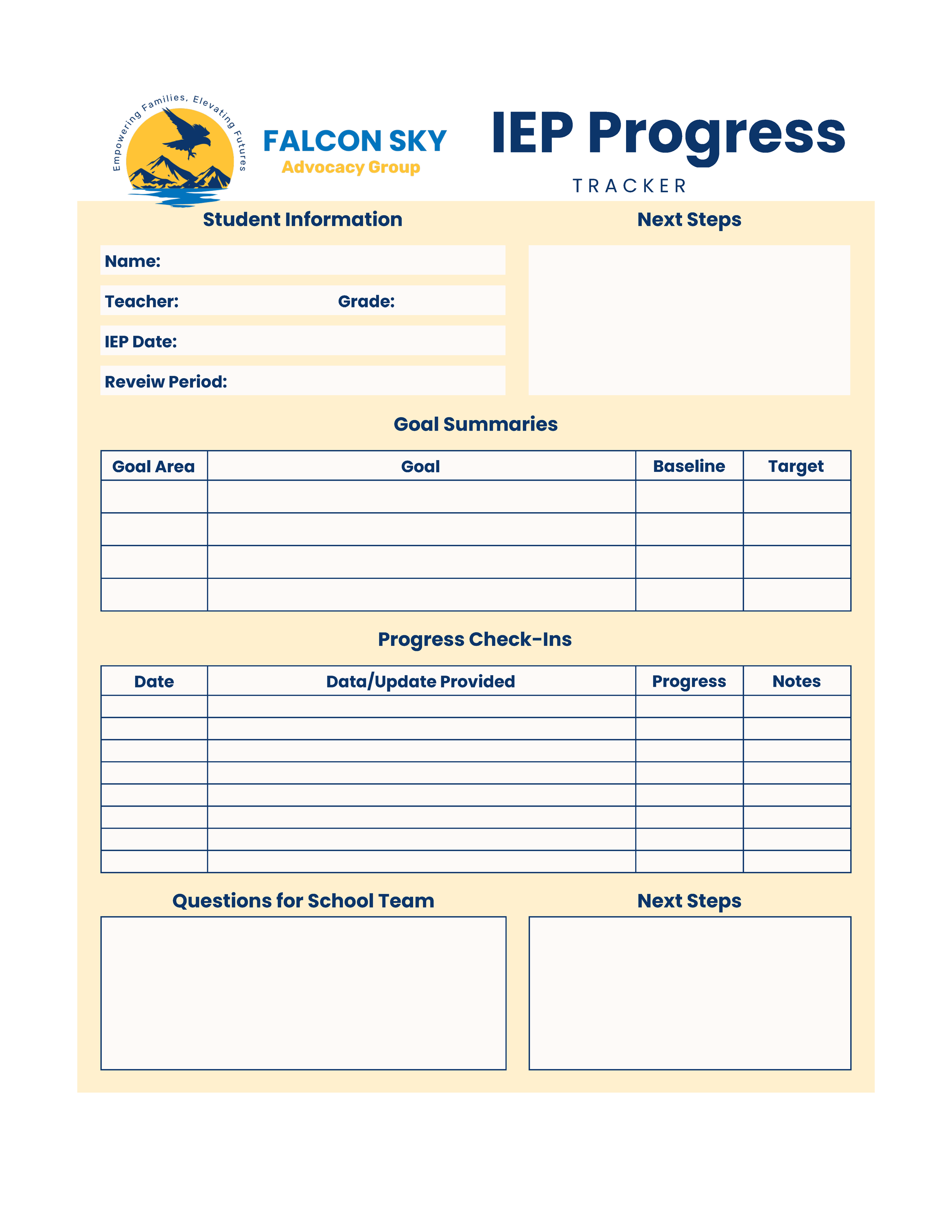Paper Trails and Pumpkin Spice
Mastering Progress Monitoring with Your Snapshot
October brings crisp air, fiery leaves, and yes—pumpkin-spiced everything. As parents settle into the rhythm of the school year, one thing shouldn’t get lost in the seasonal swirl: your child’s progress toward IEP goals.
A robust progress-monitoring system is the backbone of effective special education advocacy and ensures that services are delivered—and working—as intended.
Under IDEA, each IEP must specify “how [your child’s] progress toward meeting the annual goals . . . will be measured and when periodic reports . . . will be provided” law.cornell.edu. Yet in practice, schools often default to generic report cards that fail to illuminate the data behind the grades. Enter the Progress Monitoring Snapshot: our parent-friendly, one-page template designed to track academic and functional gains, service delivery, and observations—so you can spot trends early, celebrate wins, and address gaps before they widen.
In this post you’ll discover:
Why progress monitoring matters (and the legal requirements behind it)
How to use our free Progress Monitoring Snapshot
Best practices for creating a paper trail that fuels IEP team decisions
Real-world strategies for translating data into advocacy action
Let’s dive into the data—and make this your most informed (and pumpkin-spiced) fall yet.
The Importance of Progress Monitoring
Progress monitoring isn’t just a bureaucratic checkbox—it’s the diagnostic tool that tells you whether your child’s IEP is making a difference. Consider:
Legal Foundation: IDEA §300.320(a)(3) requires measurable annual goals and periodic progress reports “concurrent with the issuance of report cards”.
Instructional Adjustment: Data-driven insights allow teachers to tweak strategies, add supports, or introduce new accommodations in real time.
Parent Engagement: Concrete numbers and notes empower you to speak the same language as educators. No more “I feel like”—you’ll have “The data shows.”
Early Intervention: Trends of plateau or regression can trigger timely IEP reviews or 504 plan adjustments, preventing small issues from becoming big setbacks.
Without systematic progress checks, gaps may go unnoticed until an annual review—when it’s too late to pivot effectively. Your Progress Monitoring Snapshot bridges that gap.
Introducing the Progress Monitoring Snapshot
Our Progress Monitoring Snapshot is a clean, easy-to-use template that aligns with best practices recommended by Wrightslaw and the U.S. Department of Education. It captures:
Falcon Sky helps you master these tools so you can advocate effectively, even in difficult situations.
How to Complete Your Snapshot
Gather Baseline Data: Pull the original assessment scores or first few weeks of teacher logs. This establishes where your child started.
Record Service Delivery: Compare the minutes/services your child actually received to what’s written in the IEP. Under IDEA, schools must implement services as described (34 CFR §300.323(d)).
Update Progress Regularly: Aim for monthly entries or align with progress report schedules—whichever comes first.
Include Parent Observations: Note behaviors at home: increased reading willingness, frustration with certain tasks, or new skills.
Highlight Red Flags & Triumphs: Use color-coded dots (green for on track, yellow for caution, red for concern) to spotlight areas that need attention or celebration.
Keep your Snapshot in a binder or digital folder. Review it before each parent–teacher conference and share it with your IEP team to keep everyone informed.
Building a Paper Trail: Best Practices
A single snapshot is powerful—but it becomes unstoppable when backed by a thorough paper trail:
Meeting Notes: Use our downloadable notes template to capture commitments and follow-ups (34 CFR §300.503).
Email Threads: Confirm verbal agreements in writing—“As discussed, we will add a graphic organizer to the writing goal.”
Progress Reports: Request copies of any school-issued progress data, even if not formally labeled “IEP progress.” Under FERPA (34 CFR §300.613), parents have the right to inspect all records.
Timestamp Everything: Date your Snapshot entries, notes, and emails to build a chronological narrative.
Share Strategically: Distribute your Snapshot and accompanying notes to all relevant staff—teachers, aides, therapists—so there’s no confusion about your child’s supports.
These records not only inform instruction but also protect your child’s right to a free, appropriate public education (FAPE).
Turning Data into Advocacy
Numbers on a page become an advocacy springboard when you ask the right questions:
“Can we review the trend from August–October? I’m seeing a dip in accuracy.”
“Based on these service minutes, can we ensure consistency in related services?”
“I’m concerned about regression during breaks—can we discuss ESY eligibility?”
Such data-centric phrasing shifts the conversation from anecdote to evidence—making it harder for schools to overlook your concerns.
Troubleshooting & FAQs
Q: The teacher only updates progress twice a semester—what do I do?
A: IDEA mandates that progress reports align with report cards (34 CFR §300.320(a)(3)). Politely request interim updates for critical goals—offer to compile the Snapshot yourself and share it monthly.
Q: My Snapshot shows growth in one area but decline in another—when should I request an IEP review?
A: If two consecutive data points show regression or if the gap between baseline and current performance exceeds 20%, request a meeting. Use your Snapshot as evidence in the written request (34 CFR §300.503).
Next Steps & Call to Action
Don’t let your child’s progress become a mystery this fall. Download your Progress Monitoring Snapshot now and start tracking growth toward IEP goals today:
👉 Download the Progress Monitoring Snapshot
Gather your paper trail, schedule a check-in, and transform data into action. With clear insights and consistent tracking, you’ll ensure your child’s IEP delivers—and they thrive every step of the way.
Conclusion
A special education advocate plays a critical role in ensuring that children with special needs receive the education they deserve. At Falcon Sky Advocacy Group, we’re here to make that process easier for families and schools alike. Whether you need help preparing for a meeting, understanding your legal rights, or advocating for the right services, we’re committed to walking alongside you every step of the way.
Let us be your guide through the process. Reach out to Falcon Sky today and start building a path forward for your child’s success.

